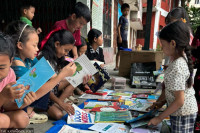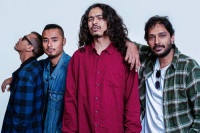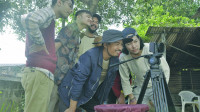Entertainment
Nude at the museum
City Museum gallery is the venue for yet another exciting art exhibition, this time by Kapil Mani Dixit.
Kurchi Dasgupta
Kapil is known for his continuing work on the naked human form for many years now, and his occasional new series have brought us in Nepal the only consistent and worthwhile forays in the genre over the past decade. Which is a pity because the unadorned human figure has been central to much of traditional Nepali art for centuries now–often as visual metaphors for both the divine and profane, and sometimes as just an everyday human subject. As the artist points out, “Kathmandu valley is full of countless erotic sculptures, wall paintings and tudals in public spaces, including temples. This has been a significant part of our religious and cultural heritage”.
The thirteen acrylic on canvas works are exciting visions of the human body shorn of all pretence and deception. Kapil has worked both from live models as well as earlier sketches done during his student years in USA. I remember the artist mention once, a few years back, that the experience of drawing live from models was something that verged on the epiphanic for him. Every time he confronts a model, male or female, he is intensely moved by an awareness of how all beings on earth are not only interconnected but are microcosmic mirrors of each other. As he puts brush to canvas and draws the first stroke, he feels he draws himself. It is his own self he explores, discovers and reveals through other human forms. Instead of sliding into exploitative objectification, the artwork breaks into a paean to humanity—irrespective of ethnicity, religion, gender or beauty. Incidentally, he has probably exhibited more male nudes than females at this exhibition and this hopefully puts to rest any question of gender bias.
Instead of moulding the flesh into delicate contours or creating a study of epidermal details, Kapil prefers to congeal flesh and bone within the bounds of stark, dark outlines. Resonant with a print-like quality, because of this concentration on line and form, as opposed to modulated surface texture, each piece is nevertheless undercut by the artist’s sculptural sensibility. More often than not, tactile materiality pervades the canvas, in opposition to his stark, linear compositions. It is indeed a rare combination! Body and Soul, Free Soul and Raphael are my clear favourites. Agony, in contrast, is most powerful but unsettling, almost offering an alternative take on Munch’s Scream.
Fluid, graceful, pained— the figures run riot on the walls in muted strains of white, ochre and gray. Strangely calming, they lead you to the altar of humanity shorn of deceit and barriers. It takes a strong will and a stronger hand to materialize these in a culture that thrives on repressed sexuality, violence and pretence. The strength of the artist’s vision takes more material form in his bronze piece called Emotional Outburst that he dedicated to his mother on Mother’s Day. Its luscious convolutions and gaping absences recreate the emotional drain a mother goes through habitually. That he is an excellent sculptor is obvious from this single piece.
Kapil Mani Dixit has much to offer. Whether we are ready to appreciate it in Nepal is up to us to decide as thinking, contemporary viewers.




 26.46°C Kathmandu
26.46°C Kathmandu











